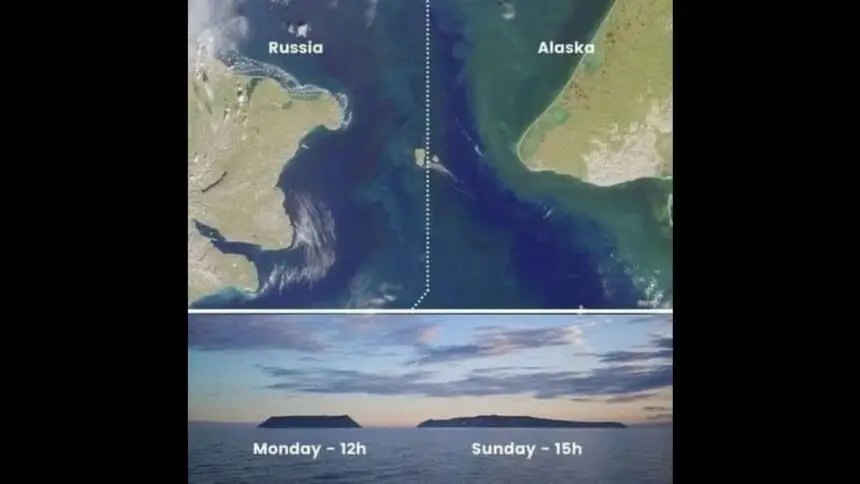Fun fact: Even though these two small islands are only 2.4 miles apart in distance, they’re 21 hours apart in time. That’s because the International Date Line runs directly between the two islands, known as the Diomede Islands. The bigger island on the Russian side is nicknamed Tomorrow Island, and the smaller island on the U.S. side is nicknamed Yesterday Island. When the U.S. bought Alaska from Russia in 1867, the two islands were used as markers to draw the new border, with the International Date Line following the borderline.
When the new border was drawn, both islands were inhabited by Inupiat people who continued to coexist as they always had, regardless of the fact that they were now residents of different countries. They used an ice bridge that would form in the winter to cross the distance between the two islands and hang out.
However, as the Cold War ramped up, travel between the two islands was forbidden, and Russia relocated all the residents of Big Diomede. The only thing left on the island today is a Russian weather station and military base. On the American side, Little Diomede still has a community of around 80 people.

Also read: Why KFC Only Follows 11 People On X? The Viral Discovery of KFC’s Twitter Account
Detailed Story of Diomede Islands
Introduction to the Diomede Islands

The Diomede Islands, comprising Big Diomede and Little Diomede, present a unique geographical phenomenon. Separated by just 2.4 miles, these two islands boast a staggering 21-hour difference in time due to the international date line that runs between them. Big Diomede, part of Russia, is known as “Tomorrow Island,” while Little Diomede, belonging to the U.S., is nicknamed “Yesterday Island.” This intriguing discrepancy has beckoned explorers and historians alike to delve deeper into their story.
Historical Context of the Islands

When the United States purchased Alaska from Russia in 1867, the Diomede Islands became crucial geographical markers for the newly drawn border, with the date line following the boundary. At that time, both islands were inhabited by the Inupiat people, who coexisted peacefully despite their newfound separation by international politics. Their ingenuity was highlighted by the winter ice bridge that would occasionally form between the two islands, allowing families and friends to gather across the border.

The Impact of the Cold War
However, the onset of the Cold War changed the fate of these islands. Travel between them was deemed forbidden, and the Russian government relocated the residents of Big Diomede, leaving only a weather station and military base behind. Today, Little Diomede still maintains a small community of around 80 residents, holding on to the rich cultural heritage of the Inupiat people.
The story of the Diomede Islands serves as a reminder of how borders can shape lives and relationships, illustrating the complexities of international relations and the resilience of communities across divides.
Also read: Types of people you cannot trust in society
Conclusion
The Diomede Islands are a fascinating example of how geography and politics can shape human lives in unexpected ways. Despite being just 2.4 miles apart, these islands are separated by a 21-hour time difference because the International Date Line runs right between them. This unique situation has led to the larger Russian island being called “Tomorrow Island” and the smaller American island “Yesterday Island.”
When the U.S. bought Alaska from Russia in 1867, the Diomede Islands became key markers for the new border, with the International Date Line following this boundary. At that time, both islands were inhabited by the Inupiat people, who continued their traditional way of life, crossing an ice bridge in winter to visit each other.
However, the Cold War brought significant changes. Travel between the islands was banned, and Russia relocated all the residents of Big Diomede, leaving only a weather station and military base. Meanwhile, Little Diomede, on the American side, still has a small community of about 80 people who maintain their cultural heritage.
The story of the Diomede Islands highlights the resilience of the Inupiat people and the impact of global events on small communities. Today, Big Diomede stands as a reminder of Cold War tensions, while Little Diomede continues to thrive, bridging the past and present in a unique way. This narrative underscores the enduring human spirit and how history and geography shape our world.








